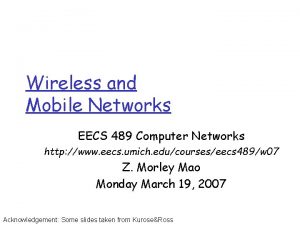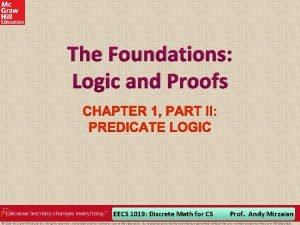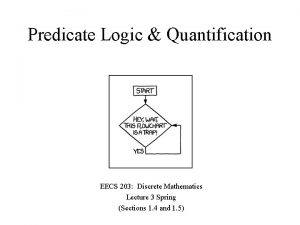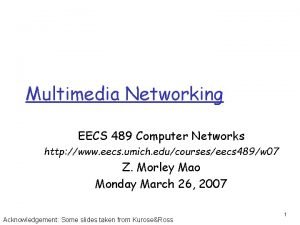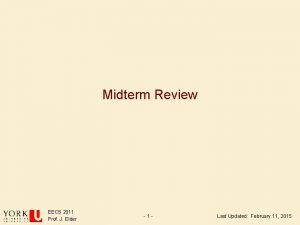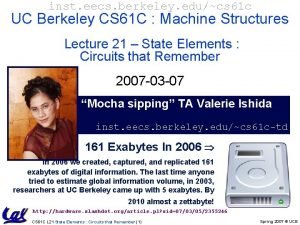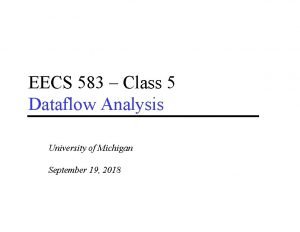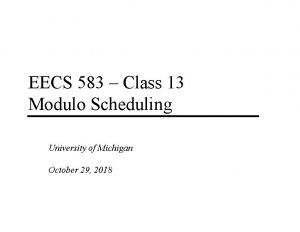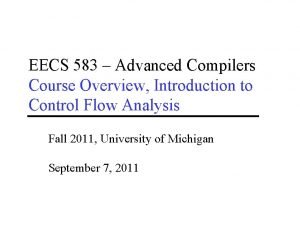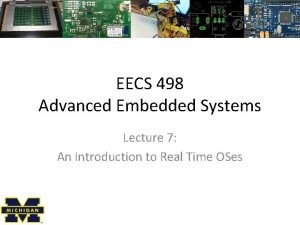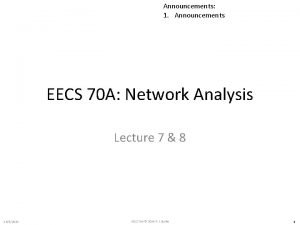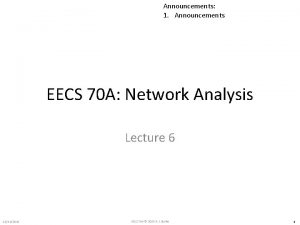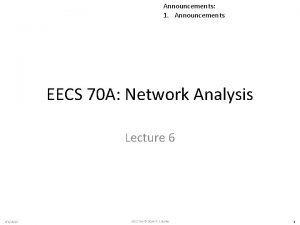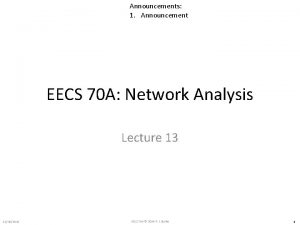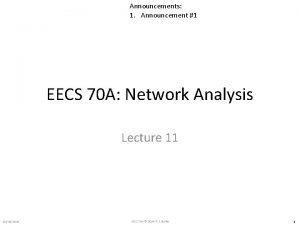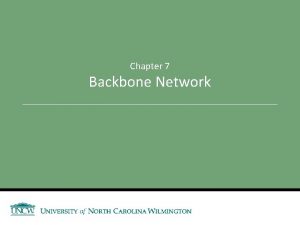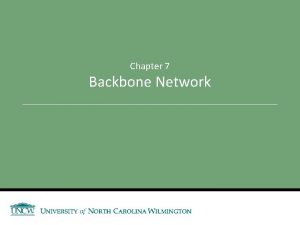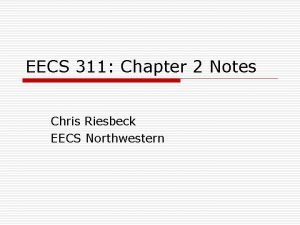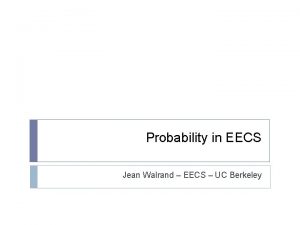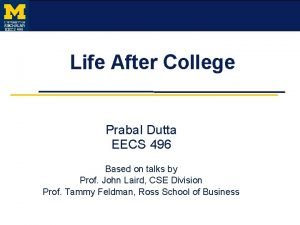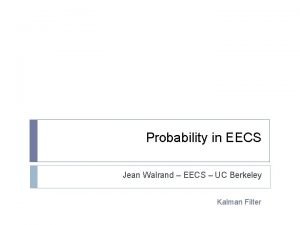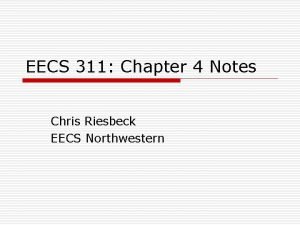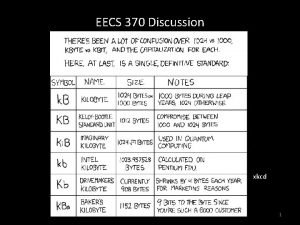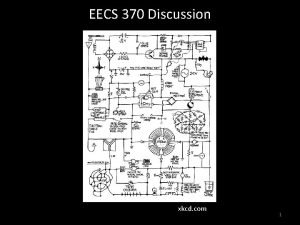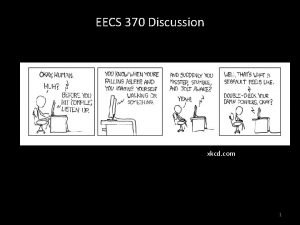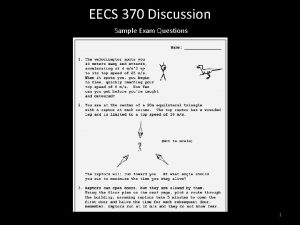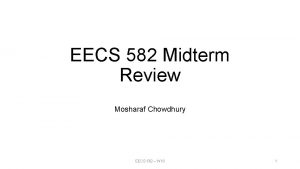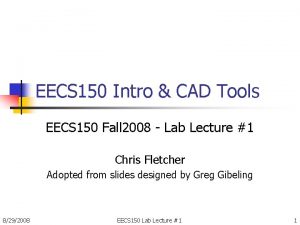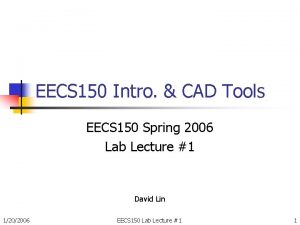Announcements 1 Announcements EECS 70 A Network Analysis



























- Slides: 27

Announcements: 1. Announcements EECS 70 A: Network Analysis Lecture 6 1/16/2022 EECS 70 A © 2014 P. J. Burke 1

Nodal Analysis(Review) Based on KCL, Use node voltages as circuits variables. 1. Define a reference node. 2. Label remaining nodes. (n-1 nodes) 3. Apply KCL + ohm to all nodes and supernodes 1. Express all I’s in terms of v’s 4. Apply KVL to loops with voltage source 5. Solve the n-1 simultaneous equations, to find V’s 6. Use Ohm’s law to find the currents. 1/16/2022 EECS 70 A © 2014 P. J. Burke 2

1/16/2022 EECS 70 A © 2014 P. J. Burke 3

Example Nodal Problem (detailed solution) R 2 R 1 3 A R 3 R 7 R 6 R 8 R 10 R 9 R 11 1/16/2022 R 5 R 4 R 12 EECS 70 A © 2014 P. J. Burke 4

1. 2. 3. Same circuit: Nodal analysis Define a reference node. Label remaining nodes. Apply KCL + ohm. i 1 i 2 R 1 i 3 R 3 i 6 3 A i 5 R 4 i 7 R 6 i 8 R 7 i 9 i 10 R 9 i 11 1/16/2022 R 2 i 4 R 11 i 12 R 12 EECS 70 A © 2014 P. J. Burke 5

1/16/2022 EECS 70 A © 2014 P. J. Burke 6

1/16/2022 EECS 70 A © 2014 P. J. Burke 7

1/16/2022 EECS 70 A © 2014 P. J. Burke 8

1/16/2022 EECS 70 A © 2014 P. J. Burke 9

Nodal Analysis-Example 0. 2 W i 1 + + V 0 0. 2 W - 0. 5 W + i 1 2 V 0 1 W 5 V 1 W 0. 5 W - 1/16/2022 EECS 70 A © 2014 P. J. Burke 10

Mesh Analysis(Review) Based on KVL, use mesh currents as circuits variables. 1. Assign mesh currents i 1 , i 2 , …in A. Create supermesh if current source 2. Apply KVL+ Ohm’s law to each mesh 3. Solve the equations for mesh currents i 1 , i 2 , …in 4. Find voltage drops 1/16/2022 EECS 70 A © 2014 P. J. Burke 11

Mesh Analysis- Example 6+v 4 W 2 W + 1 W 5 W 1/16/2022 - 12 v 3 A EECS 70 A © 2014 P. J. Burke 12

Nodal Versus Mesh Analysis • The method that results in fewer number of equations is more suitable. – Mesh analysis for networks with many series connected elements – Nodal Analysis for networks with many parallel connected elements i 2 2 W 2 W + R 3 3 A 3 W i 3 5 W R 2 R 1 - 10 V 2 A 5 A i 1 7 W R 4 R 7 R 6 R 8 R 9 R 11 1/16/2022 EECS 70 A © 2014 P. J. Burke 5 A But also depends on the type of the sources. i 4 3 W R 5 R 10 R 12 13

Nodal vs. mesh analysis? 1/16/2022 7 W i 2 2 W i 3 i 4 5 W 3 W 5 A 2 A i 1 EECS 70 A © 2014 P. J. Burke 14

Nodal vs. mesh analysis? 1/16/2022 7 W i 2 2 W i 3 i 4 5 W 3 W 5 A 2 A i 1 EECS 70 A © 2014 P. J. Burke 15

5 W - + 3 W 4 W + - 1 W - + 1 W + 1/16/2022 - 2 V 4 V 6 V 2 W Nodal vs. Mesh Analysis 3 V EECS 70 A © 2014 P. J. Burke 16

Nodal vs. Mesh Analysis R 2 R 1 3 A R 3 R 7 R 6 R 8 R 10 R 9 R 11 1/16/2022 R 5 R 4 R 12 EECS 70 A © 2014 P. J. Burke 17

Compartmentalization: Need for simplicity Power brick image. And ask class to show their own… Demo: Computer? 1/16/2022 EECS 70 A © 2014 P. J. Burke 18

Thevenin’s Theorem I a + Linear two-terminal circuit Load b Equivalent to: Vth Rth a + + - Load b 1/16/2022 EECS 70 A © 2014 P. J. Burke 19

Finding Vth, Rth a + Linear twoterminal circuit b Equivalent to: Vth Rth + - a + b 1/16/2022 EECS 70 A © 2014 P. J. Burke 20

Source/load Rsource Vsource + Rload - Derivation: Case 1: Thevenin Thm: Any circuit can be represented by this equivalent circuit. Case 2: We say Rload “loads down” the source. 1/16/2022 EECS 70 A © 2014 P. J. Burke 21

Source/load Rsource Vsource + Rload - Derivation: Case 1: Thevenin Thm: Any circuit can be represented by this equivalent circuit. Case 2: We say Rload “loads down” the source. 1/16/2022 EECS 70 A © 2014 P. J. Burke 22

Example Find Thevenin equivalent circuit: R 1 + V 1 - R 2 1/16/2022 EECS 70 A © 2014 P. J. Burke 23

Norton’s Theorem I a + Linear two-terminal circuit Load b Equivalent to: a RN IN + Load b 1/16/2022 EECS 70 A © 2014 P. J. Burke 24

Finding Vth, Rth a + Linear twoterminal circuit b Equivalent to: - a + + - RN + a IN Vth Rth b 1/16/2022 b EECS 70 A © 2014 P. J. Burke 25

Find the Thevenin & Norton equivalent circuit of the circuit below with respect to terminals a and b: Example + 60 W - + - 2 Vx + a Vx 30 V 12 W b 1/16/2022 EECS 70 A © 2014 P. J. Burke 26

“Baby” monster problem Find the Thevenin & Norton equivalent circuit of the circuit below with respect to terminals a and b: 3 V 3 A 7 W 7 W 7 W + 5 W 3 i 1 2 i 1 3 V 3 V + - + EECS 70 A © 2014 P. J. Burke 3 V - + - 1/16/2022 7 W - 7 W 3 W + 3 A 2 W i 1 - + a - 27
 Pvu announcement today
Pvu announcement today /r/announcements
/r/announcements Church announcements
Church announcements Page 113 of fahrenheit 451
Page 113 of fahrenheit 451 Kluver bucy syndrome
Kluver bucy syndrome General announcements
General announcements Difference between datagram and virtual circuit switching
Difference between datagram and virtual circuit switching What is topology in computer
What is topology in computer Features of peer to peer network and client server network
Features of peer to peer network and client server network Network systems design using network processors
Network systems design using network processors Network centric computing and network centric content
Network centric computing and network centric content Advantages and disadvantages of circuit switching
Advantages and disadvantages of circuit switching Eecs 496
Eecs 496 Eecs 489
Eecs 489 Umich eecs 489
Umich eecs 489 Umich eecs 489
Umich eecs 489 Eecs 270 umich
Eecs 270 umich Nested quantifiers
Nested quantifiers Eecs442
Eecs442 Eecs 203
Eecs 203 Eecs 489
Eecs 489 Eecs2011
Eecs2011 Berkeley eecs courses
Berkeley eecs courses Mit eecs tqe
Mit eecs tqe Eecs 583
Eecs 583 Eecs583
Eecs583 Eecs583
Eecs583 Eecs 498
Eecs 498













